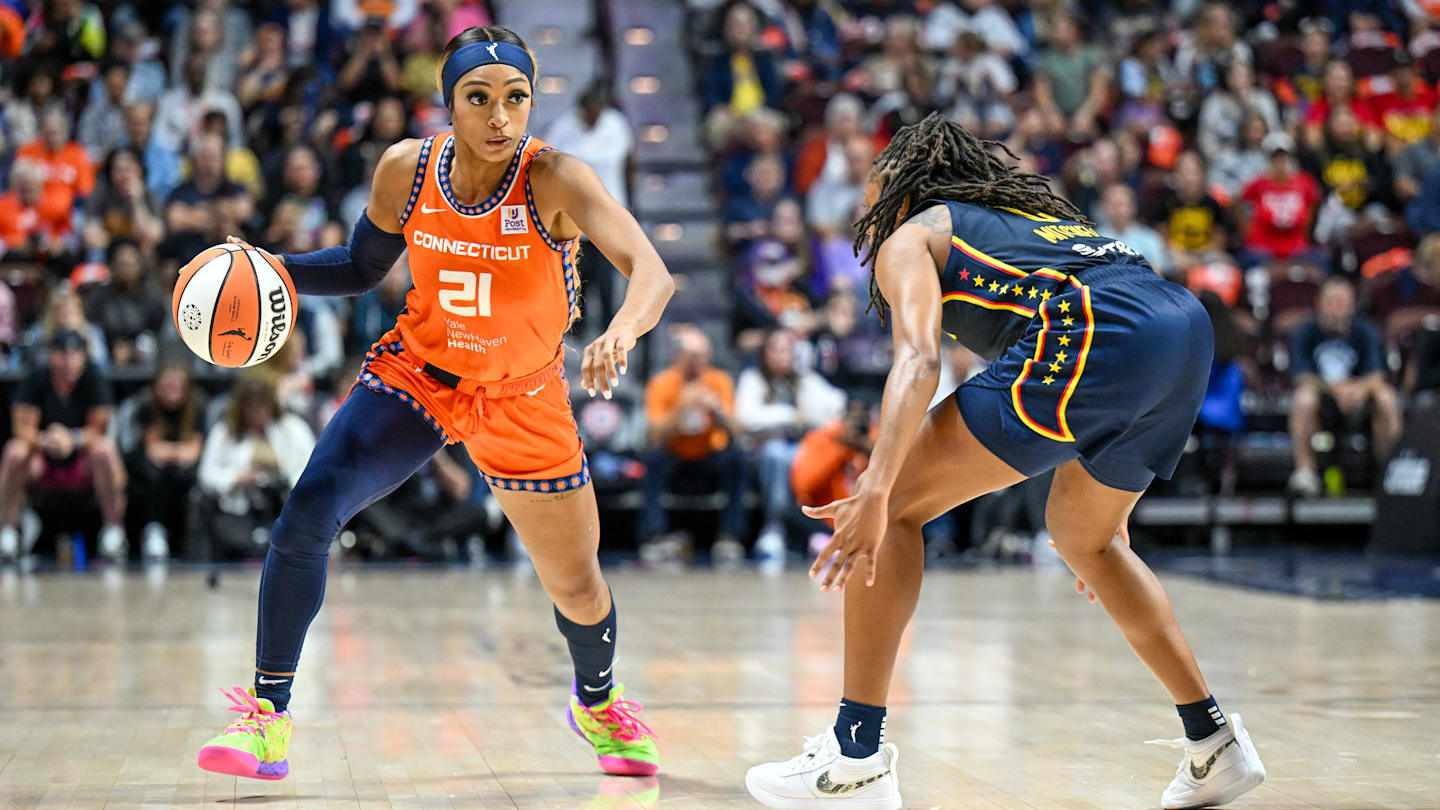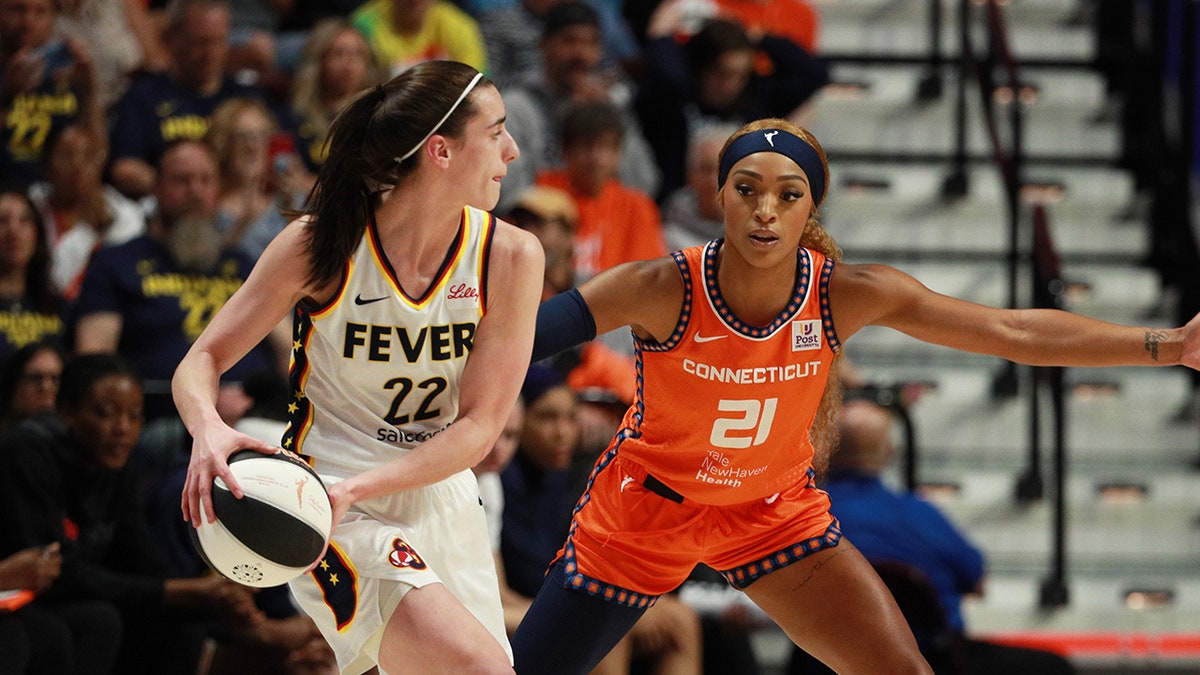Just moments into the showdown between the Connecticut Sun and the Indiana Fever, tensions flared when DiJonai Carrington appeared to swipe at Caitlin Clark’s face during a fast‐break sequence.

Clark, the Fever’s breakout rookie, crumpled to the hardwood clutching her eye—a scene that sparked immediate concern and outrage among players, coaches, and fans alike. Yet, astonishingly, no whistle blew.
Replay angles captured Carrington’s outstretched arm brushing across Clark’s orbital area, but referees opted to let play continue. The no‐call left Fever supporters in disbelief: how could a potentially dangerous act escape even a simple flagrant foul assessment?
Commentators immediately flagged the incident on live TV, labeling it an “eye poke” and questioning why officials refused to intervene.
Social media lit up within seconds. Clips of Carrington’s forearm grazing Clark’s face racked up millions of views on TikTok and X, accompanied by hashtags such as #ProtectClark and #RefsFailWNBA. Fans lamented the apparent double standard, arguing that contact meant to intimidate or injure should never be tolerated—especially when it targets the league’s most marketable player.
Caitlin Clark herself, visibly shaken, managed to return to her feet but required a brief medical timeout. “It stings, but I’m fine,” she told sideline reporters, though teammates quickly ushered her back to the locker room for further evaluation. The Ivy League star’s trademark composure did little to calm a growing chorus demanding accountability.
DiJonai Carrington declined postgame interview requests, issuing only a brief statement via her agent: “Any contact was incidental. I respect all players and would never intentionally cause harm.” Yet this explanation rang hollow to many observers given the clear video evidence showing a deliberate reach-and-swipe motion.
Veteran Fever coach Christie Sides blasted the officiating crew afterward. “We talk about player safety, but today we saw that rhetoric in action—until someone actually got hurt,” Sides said in the press room. “If we can’t protect our rising stars, we risk losing the next generation of fans and athletes.”
WNBA officiating director Derrick Collins has since acknowledged reviewing the footage. In an internal memo leaked to the press, Collins admitted that Carrington’s contact “warranted at least a flagrant 1 call.” He promised retraining sessions for referees to better recognize hand‐to‐face infractions, but he stopped short of announcing retroactive disciplinary measures.

This isn’t the first time eye‐level contact has sparked controversy in women’s basketball. Last season, a similar brush on Napheesa Collier led to a one‐game suspension for the offender. Many believe the inconsistency lies in how officials interpret intent versus outcome—an ambiguity that can leave victims feeling unprotected.
Former WNBA star and current ESPN analyst Chiney Ogwumike weighed in on live television: “We appreciate that basketball is a physical sport, but there’s a line between toughness and recklessness. When that line is crossed, it has to be called. No exceptions.” Her words echoed a widespread demand for tougher enforcement of rules against dangerous plays.
WATCH: DiJonai Carrington, Caitlin Clark Deny Harmful Intent on Game 1 Eye Poke
Fans organized a spontaneous petition demanding a league investigation into Carrington’s actions and the referees’ failure to officiate properly. Within 24 hours, more than 50,000 signatures had piled up, urging Commissioner Cathy Engelbert to impose fines or suspensions and to provide clarity on eye‐poke protocols moving forward.
The referees’ union released its own statement, noting that in real time, calls sometimes get missed in the chaos of live play. “We are human and operate within speed-of-light circumstances,” read the release. Nonetheless, the union pledged to implement enhanced training modules focused on hand‐to‐face contact—an admission of the need for systemic improvement.
Connecticut Sun head coach Stephanie White defended her player in a late‐night press conference. “DiJonai is known for her clean, aggressive play. We review all tape after games, and I stand by her intent. That said, if there’s a procedural gap in how officials handle these situations, we welcome league solutions.”
Meanwhile, video of Carrington’s reach has been dissected frame by frame by sports‐science experts. Dr. Elaine Chiu, a biomechanist, explained that even light contact near the eye can cause corneal abrasions or more serious damage. “It’s not just a bump or brush—it’s a medical risk,” she stressed, reinforcing calls for immediate rule clarification.

Caitlin Clark’s fans continue to rally around the young star. At the Fever’s next home game, volunteers distributed protective eyewear decals and “Safe Play” wristbands to highlight the issue. The arena announcer dedicated a moment of silence to player safety before tipoff, a rare but poignant gesture.
Analysts suggest the controversy could accelerate broader rule changes in the WNBA. Proposals on the table include automatic reviews for any suspected hand‐to‐face contact and stricter flagrant‐foul criteria that err on the side of protecting players. If adopted, such measures would align the women’s league more closely with the NBA’s established protocols.
What happens next depends largely on the WNBA’s willingness to act decisively. Many hope that Commissioner Engelbert will capitalize on the momentum and establish definitive guidelines. Failing to do so risks perpetuating a narrative that stars like Clark need extra safeguards while leaving lesser‐known players without recourse.
Caitlin Clark Getting Poked in the Eye by Dijonai Carrington’s Nails Has Jason Whitlock Raising Questions – The SportsRush
For now, Caitlin Clark is expected to miss at least one game while her eye heals—another unintended impact of the on‐court incident. But her absence may galvanize league officials and fans alike, reminding everyone that player safety must always trump competitive drama.
The Carrington‐Clark episode serves as a potent reminder: instant karma may expose on‐court agitators, but lasting change demands institutional will. If the WNBA truly values its stars, it must ensure that no player ever again feels unprotected under the spotlight.